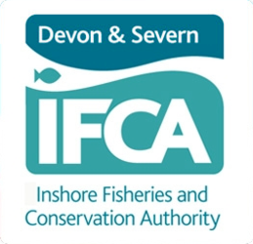Scallops
Page review/updated 24/09/2023
SCALLOP BIOLOGY
Scallops are bivalve molluscs in the family Pectenidae. There are two common species of scallops in British waters; the king or great scallop (Pecten maximus) and the queen scallop (Aequipecten opercularis). The main target species in the D&S IFCA’s District is the king scallop.
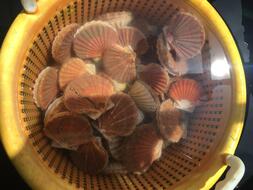
The lower (right) valve of the king scallop is convex and off-white in colour and the upper (left) valve is flat and reddish-brown. Both are marked with up to 17 distinct radiating ribs. Sessile invertebrates, such as barnacles and tube worms often grow on the shells. Maximum shell size varies with most being <150mm at the widest part of the shell. They reach reproductive maturity at a minimum size of 60mm and are fully mature at 3-5 years, living up to 20 years.
The king scallop is a filter feeder, pumping water through a filter in the gill chamber to remove particulate organic matter and phytoplankton. The scallop recesses into the sediment and orientates to the water current which is thought to help them feed more efficiently and imposes rhythms of feeding and digestion, phased with the tidal cycle. The scallop has a number of eyes around the shell margin, each of which can process images. It has several predators including large crabs, cephalopods, and a range of starfish.
The distribution range for king scallops is from Norway to the Atlantic coast of Spain, at depths of up to 200m. Settlement is on sediment, usually made up of fine sand or gravel and sometimes mud. The distribution within scallop beds has been described as patchy, with densities rarely found at one scallop per m² and are more typically 0.1-0.01 scallops per m² on good fishing grounds.
The king scallop is a simultaneous hermaphrodite with the gonad containing a creamy-coloured testis and an orange-coloured ovary. During spawning either the sperm or eggs are released first into the water column where the fertilisation takes place. Spawning usually takes place during the spring and summer however, the timing can vary between areas, and more evidence is required on spawning times in South Devon. Therefore, D&S IFCA is undertaking a project with the University of Plymouth to study spawning timing and how it varies across a range of areas: Lyme Bay, Torbay, and Start Bay. The project uses weekly samples of twenty scallops per area, all of which are being measured and assessed in the laboratory. All sampling is being conducted in collaboration with the commercial scallop divers across D&S IFCA’s District. A report on this research is expected to be available in late 2022.
SCALLOP FISHERIES
King scallops are an important national marine resource to the United Kingdom. Scallops are the third most valuable species landed by UK vessels, worth £74.1 million in first sale value in 2016, £74.5 million in 2017, £71.3 million in 2018, and £58.6 million in 2019.
The main method of capture of the king scallop in the UK is by dredge. This is normally a “Newhaven” type dredge, fitted with a spring-loaded tooth bar. The teeth can flex backwards, allowing them to pass over harder ground without snagging and breaking, and improving catch efficiency. There are usually between 2 and 22 dredges attached per side to a towing bar with rubber wheels on each end designed to roll along the seabed. The number of dredges towed by UK vessels depends on local regulations and vessel size. In the D&S IFCA’s District this is restricted to a maximum total of 12 dredges.
King scallops are also targeted by mechanical dredge and can be dive caught, though these make up less than 5% of total landings. Both commercial and recreational divers target scallops in D&S IFCA’s District. There is also scallop cultivation on a small scale.
MANAGEMENT OF SCALLOP FISHERIES
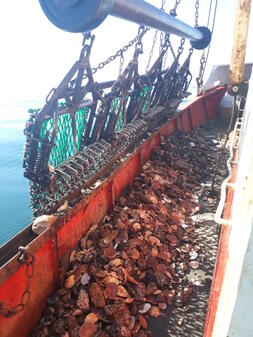
Fisheries administrations typically manage king scallop fishing by setting minimum landing sizes, restrictions on number of dredges, gear specifications, area closures and effort controls, and in some cases, such as in the D&S IFCA’s District, there are seasonal closures, time restrictions and seasonal catch limits. The dredge scallop fishery in the D&S IFCA’s District is managed via the Mobile Fishing Permit Byelaw. The Category One (at sea) Mobile Fishing Permit Conditions can be read in detail here and the Annexes (charts that accompany the Permit Conditions) can be viewed here.There are also conditions (minimum size) for scallop within the Potting Permit Byelaw Permit Conditions and the Netting Permit Byelaw Permit Conditions.
The dive-caught fishery in the D&S IFCA’s District is managed via the Diving Permit Byelaw, with tailored management measures in place for commercial and recreational divers. These have recently been revised to allow commercial divers (Category One Diving Permit holders) access to certain areas within D&S IFCA’s District during July, August, and September, subject to a new (110mm) Minimum Conservation Reference Size for scallops targeted by these divers, a daily catch limit of 2400 scallops per vessel, and a requirement for a fully functioning iVMS device to be fitted to, and transmitting from, vessels active in the fishery. The Category One Diving Permit Conditions can be read in detail here. The Annexes (charts that accompany the Diving Permit Conditions) can be viewed here. The commercial dive fishery for scallops will be closely monitored during 2022 to allow reporting to D&S IFCA’s Byelaw and Permitting Sub-Committee in early 2023. The Category Two Permit Conditions (which are tailored for recreational divers gathering sea fisheries resources for personal consumption) include daily bag limits. The Category Two Diving Permit Conditions are set out in the same documentation – with conditions relevant to that sector listed under relevant headings.
SCALLOP STOCK ASSESSMENT METHODOLOGY STUDY
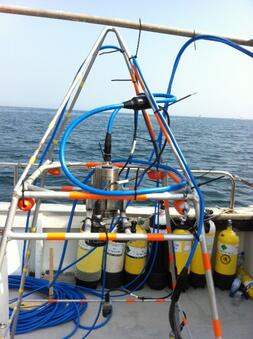
Stock assessments are an important aspect of successful fisheries management; however, little is currently known about the state of the UK scallop stocks. The traditional method of carrying out king scallop stock assessments is by dredge; however, this has been reported as having low efficiency and can be destructive. With sensitive and closed areas, and possible enhancement areas, there is a need for non-destructive methods of surveying with an increased efficiency. A Masters student undertook a research thesis, in collaboration with D&S IFCA, with the aim to investigate the suitability of different non-destructive methods of surveying within the inshore waters of Devon. A pyramid frame camera system based on Dr Stokesbury’s SMAST sampling pyramid (Stokesbury at al, 2004), which is used in America, was compared with a towed Flying Array camera system and dive surveys. The results indicated that the most appropriate method for king scallop stock assessments is the towed Flying Array camera system, which was designed by Plymouth University to undertake habitat mapping (Sheehan et al, 2010). This method can cover a large area in a short time period at different depths, and king scallop are more detectable with the oblique angle of the camera.
SALCOMBE ESTUARY SCALLOP FISHERY
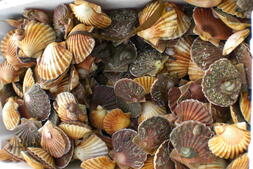
There is a small-scale highly regulated king scallop fishery operating in Salcombe Estuary in the D&S IFCA’s District. The fishery is managed under the D&S IFCA Mobile Fishing Permit Byelaw Category 2 (estuary) Permit Conditions. The fishery is restricted to a three-month period and is open from 15thDecember to 15th March. Under the permit conditions, dredging is spatially restricted to an area within Salcombe Estuary between a line drawn across the estuary from Snapes Point to Scoble Point and a line drawn across the estuary from Woodville Rocks to Ager Point, avoiding the seagrass beds. Vessels involved in the fishery must not exceed seven metres in length. Fishers can only use non-toothed dredges, no wider than 85cm, and a maximum of two dredges can be used at any one time. Dredges must be hand hauled, and fishing can only take place between 0900hrs and 1600hrs on weekdays, but not during public holidays. All scallops landed must be above the Minimum Conservation Reference Size of 100mm. Landings data must also be sent back to D&S IFCA at the end of the season.
A small-scale scallop stock assessment was undertaken to look at the abundance and sizes of scallops pre- and post-fishing for the 2011-12 and 2012-13 seasons. Several tows with the dredges were carried out over a one-day period, before and after the fishery opened and closed, with each scallop being measured.
The results showed little variation between stock levels and size distributions of scallops across the surveys.
Report: Salcombe Estuary Scallop Fishery Stock Assessment 2012/13 (October 2013).
An in-depth analysis of the catch data collected from Salcombe scallop fishery from 1998 to 2020 was undertaken in 2022. Catch per unit effort (CPUE) analysis based on days fished was undertaken for the full data set and then more in-depth analysis was undertaken on the more detailed data which was collected from 2011 onwards. For the 2011-2012 season onwards, CPUE was calculated by dividing catch by both the number of hours and number of tows fished per catch report. Hours and tows were also used to calculate landings per unit effort (LPUE) from the 2011 onwards data. Generalised linear models (GLMs) were then used to identify which variables influenced CPUE and LPUE of scallops in the Salcombe scallop fishery for the period 2011–2020. The results indicated that although there has been variation between the years, there have been no sustained declines in CPUE or LPUE. This suggests the fishery, at its current and recent historical level, is not having a detrimental impact on the harvestable scallop stocks of the estuary and that the current management measures provide an effective way to manage the fishery. The full report and results can be read here.
Page reviewed- 22/02/2023
References
Sheehan E.V., Stevens T.F., Attrill M.J. (2010) A Quantitative, Non-Destructive Methodology for Habitat Characterisation and Benthic Monitoring at Offshore Renewable Energy Developments. PLoS ONE 5(12): e14461. https://doi.org/10.1371/journal.pone.0014461
Stokesbury, K. D. E., Harris, B. P., Marino II, M. C., and Nogueira, J. I. (2004) Estimation of sea scallop abundance using a video survey in off-shore US waters. Journal of Shellfish Research, 23(1):33-40
